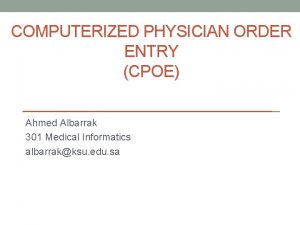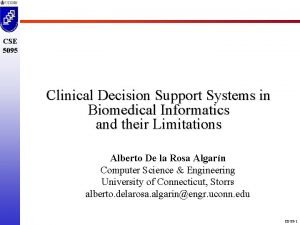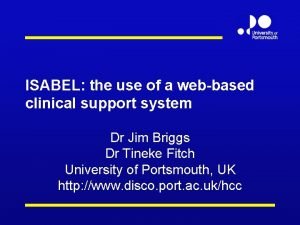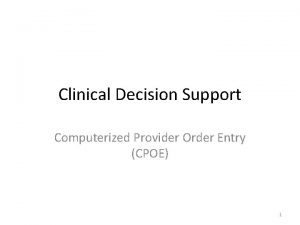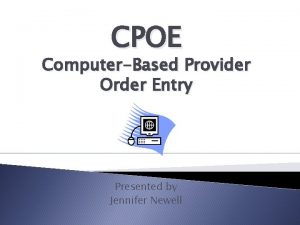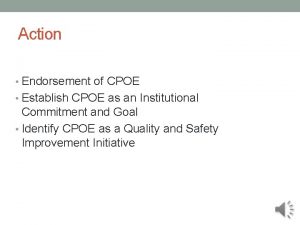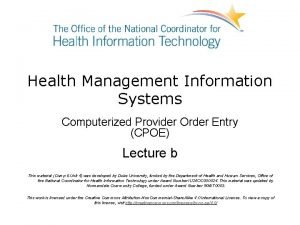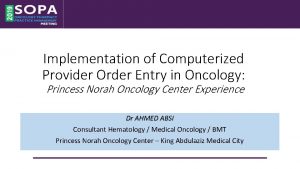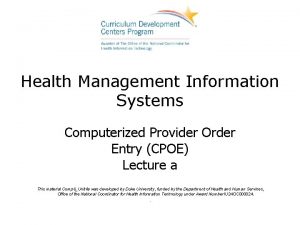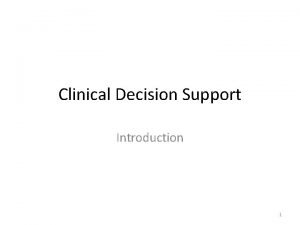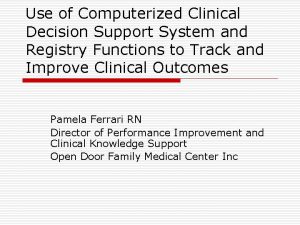Clinical Decision Support Computerized Provider Order Entry CPOE















- Slides: 15

Clinical Decision Support Computerized Provider Order Entry (CPOE) 1

There have also been some wellknown “implementation failures” • University of Virginia (Massaro, 1993) – Housestaff rebelled over system, which was implemented with very little of their input • Cedars-Sinai Hospital, Los Angeles (Chin, 2003) – Users felt it significantly impeded their workflow – Was a home-grown (non-commercial) system implemented without adequate planning – Two years later, CPOE was still not reimplemented (Connolly, 2005) 2

As well as some negative results (and rebuttals) • Koppell, 2005 – Bates, 2005 • Koppell, 2005 • Han, 2005 – Del Baccaro, 2006 • Ammenwerth, 2006 – Jacobs, 2006 – Phibbs, 2006 – Sittig, 2006 3

Koppel, 2005 • Analysis of Technicon system (old version, no longer sold) was reported by users to introduce errors in 22 situations falling into two categories – Information errors – due to fragmentation of information or failure to integrate with other systems, e. g. , medication discontinuations, immediate orders, conflicting or duplicate medications – Human-machine interface flaws – system functions do not correspond to work organization or usual behaviors, e. g. , information scattered across multiple screens, inflexible screens making non-standard modifications difficult 4

Criticisms (Bates, 2005) and rebuttals (Koppel, 2005) • Bates – Did not count errors or, more importantly, adverse events – Did not count errors that were prevented – Studied older version of software requiring multiple screens and long since updated – CPOE is a process requiring continuous improvement • Koppel – System was old, but represented what might be found in commercial system (as opposed to home-grown systems studied by Bates) – Error types were stated by users based on their real experiences – Agreed in value of CPOE but called for it to be studied more thoroughly to identify potential to do harm 5

Han, 2005 • Retrospective pre (18 months) and post (5 months) analysis in a Children’s Hospital of Pittsburgh • Mortality rate increased from 2. 80% to 6. 57% • Problems with CPOE noted to be – Inability to write orders before patient arrival – Time-consuming nature of order entry – Centralization of medications 6

Rebuttals to Han study • Others did not find increased mortality rates – University of Washington (Del Baccaro, 2006) • Comparison of this paper with Han paper by CPOE experts identified implementation differences (Ammenwerth, 2006) – Cincinnati Children’s Hospital Medical Center (Jacobs, 2006) • Before-after retrospective studies always have risk of confounders; could there be other explanations for outcome? – Inadequate wireless network, centralization of pharmacy, non-use of order sets (Phibbs, 2005) 7

Lessons learned from Han study (Sittig, 2006) • Roll-out (hospitalwide in six days) too quick • Order entry is possible before patient arrival – planning should have allowed • Centralization of pharmacy a confounding factor and not requirement for CPOE • Variety of communication issues, including keeping nurses and others at bedside • Adequate network bandwidth essential • Standardized order sets would have reduced large number of clicks (and time) per order • Informatics expertise could have been helpful 8

There also “unintended consequences” of CPOE Unintended consequences – developed (Campbell, 2006), identified in 5 settings (Ash, 2007), and verified by survey in 176 more (Ash, 2007) - New work/more work - Workflow - System demands - Communication - Emotions - New kinds of errors - Power shifts - Dependence on technology 9

Can we reduce time for order entry? • Concern about time described in more detail in segment 4. 6 • Wizorder (Giuse, 2003) guides clinicians and anticipates next steps • Lovis (2001) developed system to map entered text to actions in VA CPRS – e. g. , Ranitidine 50 mg IV q 8 – Found time to enter admitting order set reduced from 17. 7 to 16. 1 minutes 10

Overrides of CPOE advice • Bates (1999) study of redundant lab tests – 31% of suggestions for cancellation overridden – Only 41% were deemed justified by expert review • Hsieh (2004) assessment of drug-allergy overrides – 80% of alerts overridden, usually due to “aware/will monitor” (55%) and “patient does not have this allergy” (33%) – Still resulted in 6% rate of ADEs in patients, although all were judged clinically justifiable • In one VA study, only 20% of reasons given for drug interaction overrides were deemed “clinically useful” by pharmacists (Grizzle, 2007) 11

Overrides (cont. ) • Study of 2872 clinicians in 3 states of 233, 357 medication alerts (Isaac, 2009) – 6. 6% of all prescriptions generated alerts – Clinicians only accepted 9. 2% of drug-interaction and 23. 0% of allergy alerts – Most interaction alerts were “high-severity” (61%), which were slightly more likely to be accepted – Alerts less likely to be accepted if patient was already on medication • “Tiering” of alerts so only more critical situations generated work-stopping alerts led to increased accepting of more critical alerts (Paterno, 2009) 12

Other problems with CPOE • About 1% of prescriptions have inconsistency between structured template and free-text field (Singh, 2009) • Qualitative data from field observations and interviews shows impacts to clinical workflow from alteration of clinical activities and incomplete support for work activities (Campbell, 2009) • Better attention to workflow may improve practice with CDS (Karsh, 2009) • One quality advocate calls for priority of bar-coding over CPOE (Wachter, 2008) • Need better use of clinical knowledge management tools (Sittig, 2010) 13

What about E-Prescribing? • Growing call for all prescriptions to be electronic (e. Health Initiative, 2008; e. Health Initiative, 2008) • National e. Prescribing Patient Safety Initiative (NEPSI, www. nationalerx. com) provides free software for ambulatory E-Prescribing – But increasingly used within EHR systems • Uptake increased substantially between 2008 to 2009 (Surescripts, 2010) – Number of prescriptions: 68 million to 191 million – Number of prescribers: 74, 000 to 156, 000 (one-quarter of all prescribers) – Surescripts could provide access to benefits and history of 65% of US patients – 85% of all pharmacies able to receive prescriptions electronically 14

Grand challenges for CDS (Sittig, 2008) • Improve the effectiveness of CDS interventions – – – Improve the human-computer interface Summarize patient-level information Prioritize and filter recommendations to the user Combine recommendations for patients with co-morbidities Use free-text information to drive clinical decision support • Create new CDS interventions – Prioritize CDS content development and implementation – Mine large clinical databases to create new CDS • Disseminate existing CDS knowledge and interventions – Disseminate best practices in CDS design, development, and implementation – Create an architecture for sharing executable CDS modules and services – Create Internet-accessible CDS repositories (rules. gov? ) 15
 Computerized physician order entry definition
Computerized physician order entry definition Iliad clinical decision support system
Iliad clinical decision support system Isabel clinical decision support
Isabel clinical decision support No decision snap decision responsible decision
No decision snap decision responsible decision Financial management process
Financial management process Cpoe
Cpoe History of cpoe
History of cpoe Cpoe vs e prescribing
Cpoe vs e prescribing 1st order 2nd order 3rd order neurons
1st order 2nd order 3rd order neurons Single entry system
Single entry system Generating and exploiting new entries
Generating and exploiting new entries Distinguish between single entry and double entry
Distinguish between single entry and double entry Clinical research support services
Clinical research support services Decision table testing
Decision table testing Decision tree and decision table examples
Decision tree and decision table examples Types of tps system
Types of tps system
